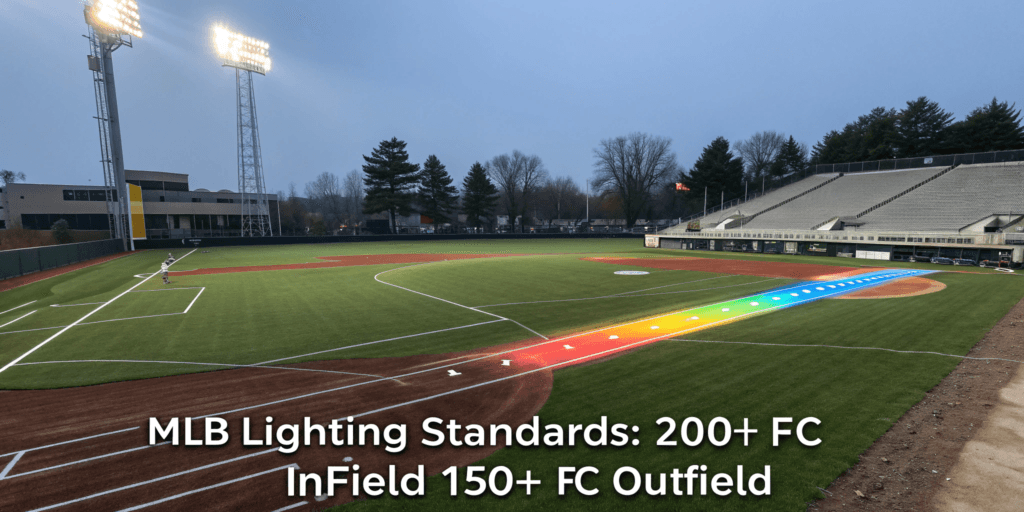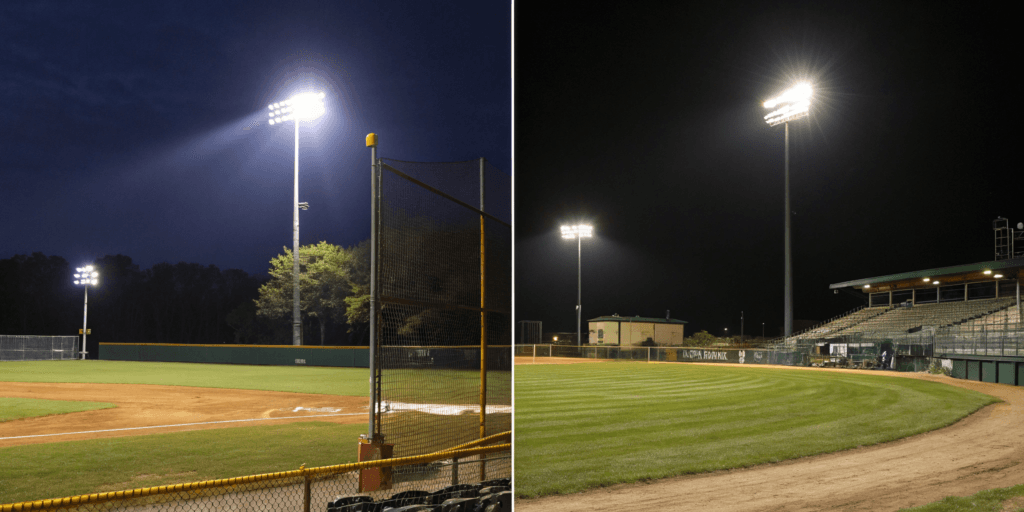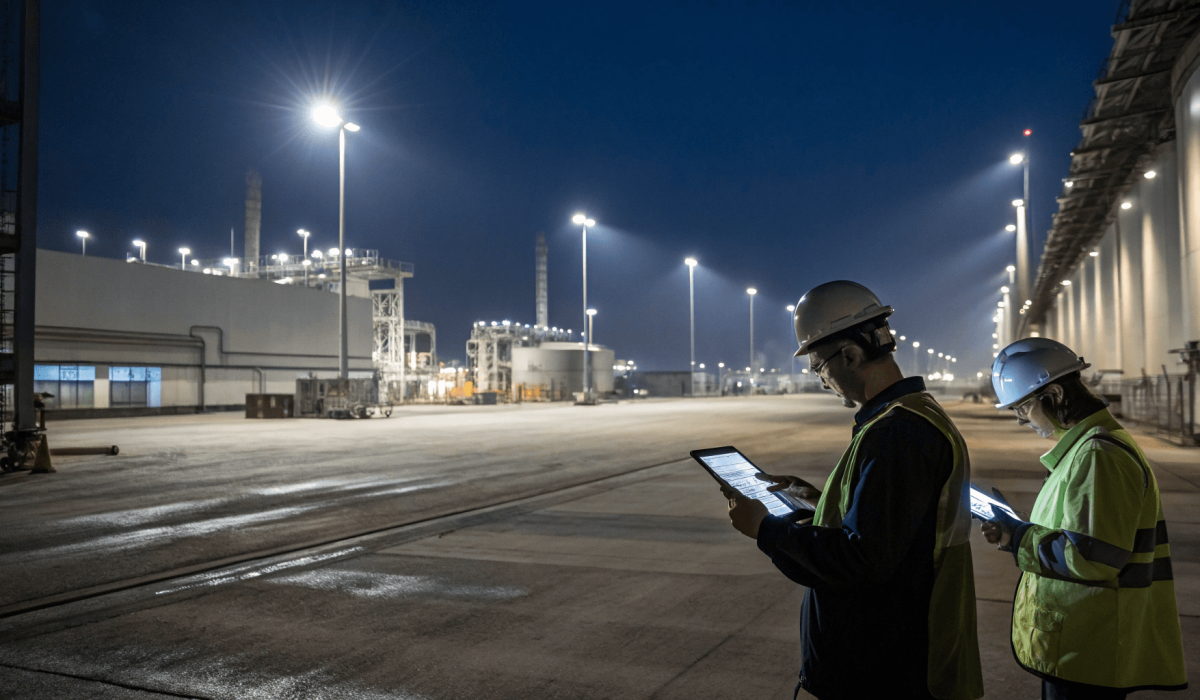A shaky high mast light isn’t just annoying—it’s a safety red flag.
If your high mast light shakes in the wind, the root cause is almost always a weak or poorly constructed foundation. Fixing it is not optional—it’s essential.
That swaying pole could collapse or cause lighting failure. Let’s break down what’s happening and how to fix it.
What Is a High Mast Light?
It’s not just a tall pole with lights on top.
A high mast light is a tall lighting structure used to illuminate large areas like highways, stadiums, ports, and industrial zones. Heights range from 20 to 50 meters, covering up to 50,000 square meters with powerful LED luminaires.
Common Components
- Pole: Typically tapered or polygonal
- Luminaire Ring: Holds multiple LED lights
- Lowering Device: Enables safe ground-level maintenance
- Foundation: Supports structural load and wind resistance
These systems are exposed to strong wind forces. If the foundation is weak, the entire structure is at risk.
Why High Mast Lights Shake in Wind?

When wind shakes your light, it’s the foundation crying out for help.
Most high mast vibration issues come from four critical mistakes in foundation design or soil preparation.
1. Inadequate Foundation Depth or Size
A shallow base means a weak anchor.
Poles must resist wind-induced overturning. If the base isn’t deep or wide enough, especially for poles above 30m, shaking becomes inevitable. Many problems come from ignoring the 1/10 rule (foundation depth = 1/10 pole height).
| Pole Height (m) | Recommended Foundation Depth (m) |
|---|---|
| 20 | 2.0–2.5 |
| 30 | 3.0–3.5 |
| 40 | 4.0–4.5 |
2. Poor Soil Conditions or Improper Soil Compaction
The best foundation fails on bad soil.
Loose or saturated soil reduces the structure’s ability to stay upright. Without proper soil compaction, high mast poles settle or tilt over time. That movement is often misread as “wind shaking.”
3. Incorrect Bolt Grouting or Anchoring
Loose bolts = shaky pole = dangerous pole.
Anchor bolts that are improperly grouted, corroded, or unevenly torqued allow vibration to amplify with each gust of wind.
4. Wrong Pole Design for Wind Load
A pole made for one wind zone may fail in another.
Every region has different wind load codes (ASCE 7, Eurocode, etc.). A pole rated for 90 kph may vibrate violently in 120 kph zones. Plus, stepped poles (not tapered) catch more wind.
How to Fix Foundation Issues in High Mast Lighting?
There is no one-size-fits-all repair—but there are solid steps to recovery.
Start with a full structural assessment. Then, reinforce or replace the foundation as needed.
1. Conduct a Structural Assessment
Hire a licensed engineer to:
- Inspect anchor bolts for wear and corrosion
- Measure vibration frequencies
- Review original installation drawings
You may also run a vibration resonance test to find if the wind speed aligns with the pole’s natural frequency (a major cause of shaking).
2. Foundation Reinforcement Techniques
Sometimes you can strengthen without tearing everything out.
Common Fixes:
| Method | Application |
|---|---|
| Concrete Encasement | Adds width and weight |
| Deep Pile Retrofitting | Improves depth and load transfer |
| Grouting/Epoxy Repair | Strengthens loose anchor bolts |
These methods reduce movement and extend pole life.
3. Replace or Upgrade Foundation for Long-Term Stability
If the foundation is flawed beyond repair, start fresh.
Follow national or international standards:
- Use ASCE 7 for US-based wind load
- Eurocode EN 1991 for Europe and parts of Africa
Base design on wind map zone, soil bearing pressure, and pole weight.
How to Properly Design a High Mast Light Foundation?

Want to avoid shaking forever? Design it right the first time.
The key is site-specific planning based on soil, wind, and pole height.
1. Site-Specific Geotechnical Survey
Never skip the soil test.
Check:
- Soil type (clay, sand, rock)
- Load-bearing capacity (kPa)
- Groundwater level
- Seasonal shrink/swell behavior
Geotech reports tell you whether to use a shallow or deep foundation.
2. Wind Load Calculations
Every pole must be matched to the worst-case wind for that site.
Key Factors:
- Local wind speed (e.g. 120 kph in coastal zones)
- Pole surface area and drag coefficient
- Gust factor and exposure category
Use:
- ASCE 7 wind maps for US projects
- Eurocode EN 1991 for most African installations
3. Recommended Foundation Types
| Foundation Type | Best For | Notes |
|---|---|---|
| Shallow Footing | Good soil conditions | Depth = ~1/10 pole height |
| Pile Foundation | Weak or wet soil | More expensive, highly stable |
| Caisson Foundation | Rocky terrain | Needs drilling |
Reinforce all designs with proper rebar cages and anchor bolt cages.
Other Causes of High Mast Pole Instability (and Fixes)?

Sometimes the pole shakes even when the foundation is solid.
Other Potential Issues
- Lowering system not fully locked – causes internal movement
- Overloaded luminaires – adds top-heavy sway
- Pole corrosion – especially at the base
- Unbalanced light layout – shifts center of gravity
Fixes
- Tighten winch locks
- Check luminaire load against pole specs
- Rust-proof base annually
- Balance lighting layout symmetrically
Safety Risks of an Unstable High Mast Light?
This is more than a maintenance problem—it’s a public safety risk.
An unstable high mast light can collapse, damage property, and injure people.
What’s at Stake:
- Structural collapse from fatigue cracks
- Insurance and liability claims
- Public hazard near roads, stadiums, or ports
- Emergency repairs that cost far more than prevention
If shaking is noticed, shut the light down immediately and inspect it.
Maintenance Tips to Prevent Pole Shaking and Foundation Issues?

The best fix is never needing one. That’s what maintenance is for.
What to Do Regularly:
- Torque anchor bolts every 6–12 months
- Visual checks after storms
- Reapply anti-rust coating to pole and base
- Check for water pooling near foundation
- Log vibration behavior if sensors are installed
Regular care saves thousands in future repairs.
FAQs: High Mast Light Foundation and Wind Stability?
How deep should a high mast light foundation be?
Roughly 1/10 of the pole height. For a 30m pole, aim for 3m deep.
Can I stabilize an existing pole without replacing it?
Yes, using concrete encasement, bolt grouting, or micro-pile retrofits.
What wind speed can a high mast light withstand?
Depends on design—typically 120–160 kph. Check wind load certification.
How often should foundations be inspected?
Every 12 months, or after major storms or seismic events.
Is vibration normal in high mast poles?
Slight movement is okay. Constant or large shaking is not.
Conclusion
If your high mast light shakes in the wind, don’t ignore it. The problem usually starts underground—with the foundation. A smart fix today avoids a costly disaster tomorrow.


